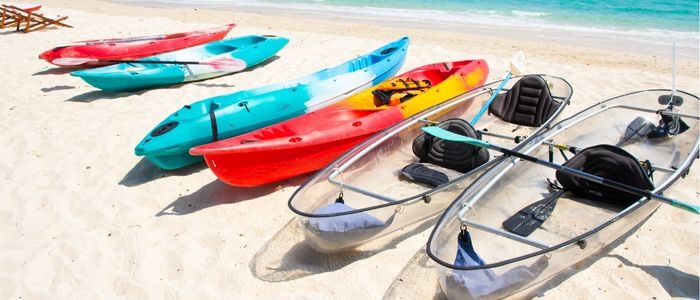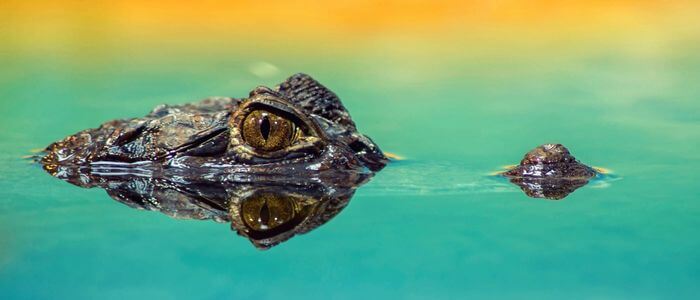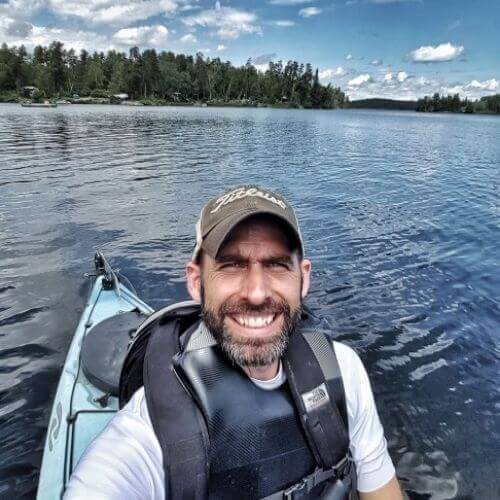
Kayaking is a fun and peaceful activity, but it can quickly become dangerous if you come across an alligator. Seeing an alligator while kayaking can be a life-threatening experience, so it’s important to know what to do if you find yourself in this situation.
Please note that any advice on this website (kayakguidance.com) is strictly for entertainment purposes only and we are not responsible for any damages, you the reader are responsible for your own safety.

If you are in a kayak and see an alligator, you should stay calm, slowly paddle away, and take steps to appear larger and get out of the water.
If you see an alligator far away while kayaking, the first step is to assess the situation. This includes determining the distance between you and the alligator, the direction the alligator is facing, and whether it appears agitated. It is important to note that alligators are typically more active during the warmer months, so be extra cautious during these times.
Alligators are territorial animals, so if they feel their home is being threatened, they will fight to protect it. Keep a safe distance from the alligator, and don’t get too close.
If you are too close to the alligator or it appears to be heading in your direction, it is best to change your course and paddle away from the alligator. This will help to avoid a confrontation and keep you safe.
The most important step in encountering an alligator while kayaking is to remain calm. Alligators can sense fear and agitation; if you panic, you may inadvertently provoke the animal. Remain as still and quiet as possible, and avoid making sudden movements.
If you have assessed the situation and determined that the alligator poses a potential threat, it is time to paddle away slowly. Do not make any sudden movements or loud noises that could startle the animal. Instead, use a smooth and steady motion to paddle away as quickly as possible without agitating the alligator.
Another way to deter an alligator from approaching you is to make yourself appear larger. Stand up in your kayak, raise your arms, and paddle above your head. This will make you appear larger and more intimidating to the alligator. (This mainly applies if you have a large kayak or on a boat)
If you encounter an alligator while kayaking, the best action is to get out of the water as soon as possible (get to land as soon as possible). Alligators are most comfortable in the water, where they can move quickly and delicately. However, they need to be more agile on land and can be outrun by humans. If possible, make your way to the shore or a nearby island to get out of the water.
If you feel threatened or uncertain when the alligator is approaching you, it is important to seek help immediately. This can include calling for help on a radio or cell phone or seeking assistance from a nearby ranger or park staff.
If you are kayaking in a park or protected area, it is important to follow all rules and regulations to ensure the safety of yourself and the alligator. This may include staying on designated trails, not feeding the alligators, and following any other guidelines set forth by the park.
Like all living creatures, alligators need to eat and reproduce to survive. They also need to maintain a proper body temperature. However, unlike humans, alligators are cold-blooded, meaning they cannot regulate their body temperature. To maintain their body temperature, alligators will seek out warmer environments.
For example, if the sandbar is warmer than the water, alligators will exit the water and bask in the sun. Alligators will float in the water if the water temperature is warmer than the air temperature.
This is often the case during the night and early morning when the air temperature is still cool. If you see an alligator sunning itself out of the water, it is doing so out of necessity and would prefer to be in the water if the temperature was more suitable.
Although alligators are known for their territorial behavior, they typically do not have much interaction with kayakers in the area. Due to their cold-blooded nature, they spend most of their time in the sun on the swamp’s shores.
If they are alerted to the presence of kayakers by their sensitive hearing, they will quickly retreat into the water to hide.
When hunting or defending their territory, alligators often look for places to blend in with their surroundings. The trees and floating brush along the edges of the swamp provide excellent camouflage. Kayakers who stay in open water are unlikely to encounter them.
Although alligators are typically docile and do not seek interaction with humans, it is important to be cautious when kayaking in areas where they may be present. To avoid disturbing them, it is best to avoid pointing your kayak directly at them and to use a smooth and steady stroke. Agitated or fast movements can cause them to become uneasy.
As you observe, you may notice an alligator’s belly expanding and its back rising out of the water. Additionally, you may hear the sound of its jaws clapping or snapping. During this behavior, the alligator may also swim toward you, sinking and resurfacing while getting closer or not moving away.
If you see an alligator while kayaking, you should avoid the alligator. Do not attempt to approach or touch the alligator, as this can be extremely dangerous. Instead, keep a safe distance and slowly back away while keeping an eye on the animal. If the alligator begins to show aggressive behavior, such as charging or hissing, quickly paddle away and seek safety on shore.
It is important to remain vigilant and aware when observing such behaviors. Even if the alligator charges, it is likely a false charge, and they will often change direction and dive, creating a loud splash. While this can be intimidating, knowing how to respond can keep you safe.
It’s important to know where alligators might live because female alligators are known to protect their nests and young with their lives. If you see a raised mound in a pond, it is probably an alligator nest.
You should stay away from it until you are sure it is empty. But in places like the Turner River in Big Cypress, where people kayak a lot, mother alligators may be used to seeing people and not be a threat. Still, you should always be careful when visiting places where alligators live.
Following are some safety tips for kayaking around alligators:
Paddling alone in an alligator-populated area can seem daring. However, nothing is worth risking an attack. Alligators move quickly and silently, so it’s hard to catch sight of them before it’s too late.
A partner or guide can help spot any creatures in the water so you are informed and a few steps ahead if you encounter one. Having someone with you also gives you a better chance of being able to call for help should you come face-to-face with a wild alligator.
While kayaking may be an invigorating experience, always prioritize safety while participating in this adventurous activity.
Despite their potential danger, alligators are typically rather shy and will most likely remain out of sight. They are also nocturnal, so although there is a slim chance of spotting one during the day time, it is even slimmer at night.
Therefore, when kayaking, it is always a good idea to be aware of your surroundings and listen for any unusually loud noises that could indicate an alligator nearby. If you see floating logs in the water or heads poking above the surface, take caution, as these may actually be sleeping alligators.
Being mindful of such signs should help ensure that you stay safe from any potential danger from alligators.
Alligators may seem docile, but they are still wild animals and need to be respected. If a kayaker is out on the water and finds themselves near an alligator, the best option is to keep their distance.
Alligators who have been human-fed or interacted with before can sometimes become dangerously aggressive. So it’s important for kayakers out on the water to remember one thing: don’t feed or approach any alligators – no matter how tempting it might be!
Doing so can put you in serious danger and also upset the delicate ecosystem in which they live. Play it safe when kayaking; admire these amazing creatures from afar.
Kayaking is a great way to experience nature and take in the beauty of your surroundings, but it’s important to remember to stay safe.
One of the best ways to do so is by keeping your hands and feet inside the kayak at all times, regardless of how low you feel like dipping them in the water. Not only will this help keep you from losing your balance and tipping over, but it also prevents accidental contact with wildlife, such as alligators, that could potentially be lurking nearby.
Being aware of your environment is key to enjoying kayaking safely. So next time you’re out on the water, remember: to keep your hands and feet inside the kayak at all times.
It’s a frightening experience to come across an alligator while out enjoying nature in the swamp or lake. Alligators are not picky eaters, as they prey on fish, birds, small mammals, and even other gators.
Consequently, when animals recognize the presence of a predator, they should be avoided. The situation is even more dangerous if you come across an alligator that is sunning itself on the bank of a lake.
These reptiles do not usually attack people unless provoked; however, it’s best to take caution and stay back. If you see one, keep your distance for your own safety so you can admire its beauty from afar with peace of mind.
Alligators may be known as fierce predators. However, even the gentlest of alligators can bite if they are startled. This is why it’s important to never put your hand or arm in any hole or crevice where an alligator could have made its home; even a single tap on the side of the crevice could set off an unexpected reaction that could cause serious injury.
An alligator’s powerful jaws and sharp teeth can cut right through flesh like butter, so it’s best to take precautionary measures such as not touching anything you are uncertain of in locations likely inhabited by gators.
By being cautious around these beautiful yet dangerous creatures, everyone has a better chance of avoiding potential bites and staying safe around alligators.
Kayaking in the early morning or twilight can be a peaceful and magical experience, but it can also put you at risk. Alligators are more active during the cooler morning and evening hours, making it more likely that they will encounter kayakers while they are hunting.
Therefore, to stay safe while kayaking, it’s important to avoid these times – dawn and dusk – when alligators are most active. Planning adventures for other parts of the day is the best way to ensure that you won’t come across them unexpectedly and unknowingly enter their territory.
Kayaking around alligators can be a thrilling experience if you know how to stay safe.
By following these safety tips, you can ensure that your adventure does not become a nightmare. So remember: always keep an eye out for alligators and remain alert when paddling in their territory!
Kayaking is a popular outdoor activity that allows people to explore nature’s beauty and enjoy the water’s tranquility. However, it is important to remember that kayaking also brings the potential for encountering dangerous wildlife, such as alligators.
Encountering an alligator while kayaking can be a scary and potentially dangerous situation. However, following the steps outlined in this article can minimize your risk and stay safe. Stay calm, keep your distance, and avoid sudden movements. If you encounter an alligator, use your paddle as a defensive tool and quickly paddle away. Always be aware of your surroundings and respect the wild animals that call our waterways home.

Hey there kayak lovers! I’m Jay Schwartz, the author here at Kayak Guidance! You know water sports – you know me! My life is all about it. Kayaking, Paddleboarding, Fishing, Snorkeling and so much more. I love to share my passion and knowledge with all of you.

Hey there kayak lovers! I’m Jay Schwartz, the author here at Kayak Guidance! You know water sports – you know me! My life is all about it. Kayaking, Paddleboarding, Fishing, Snorkeling and so much more. I love to share my passion and knowledge with all of you.

Welcome to KayakGuidance.com! If you’re looking to have some fun outdoor water adventures, then you have come to the right place. We help our readers find the best kayaks and water related equipment to help you have the best time of your life whenever you are engaging in water activities.
This site is a participant in the Amazon services LLC associates program, an affiliate advertising program designed to provide a means for sites to earn advertising fees by advertising and linking to Amazon.com.